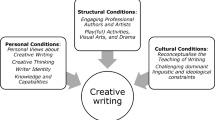Abstract
Although there is ample interrogation of advertising/commercial/media culture in critical pedagogy, there is little attention paid to the fine arts and to aesthetic experience. This lacuna is all the more perplexing given Paulo Freire’s use of artist Francisco Brenand’s illustrations (Education for Critical Consciousness. Continuum, New York, 1973) for his culture circles. In this essay I will return to Freire’s original description of the relationship between fine art images and conscientizacao in order to map out the future of the image in critical pedagogy. This return to the origin of the use of images in literacy programs will highlight the interdependent nature of word and image but also will demonstrate some of the long standing misconceptions of the way fine art images function in relation to education and politics. In conclusion I will suggest that if images have a future in critical pedagogy, then this future must ultimately move beyond Freire. As an alternative genealogical anchoring point for the development of the aesthetics of critical literacy, I suggest a turn to the work of Jacques Rancière. Through his conceptualization of the “pensive image” as well as the “emancipated spectator” we can begin to understand how the fine art image can work to realize Freire’s democratic ideals without relying on Freire’s problematic formulation of the image-pedagogy relationship. In conclusion, I suggest that the philosophical model necessary to support critical literacy is not Freire’s culture circle so much as Kant’s aesthetic community now revitalized via Rancière’s own aesthetics of dissensus.
Similar content being viewed by others
References
Basualdo, C., & Laddaga, R. (2009). Experimental communities. In B. Hinderliter, W. Kaizen, V. Maimon, J. Mansoor, & S. McCormick (Eds.), Communities of sense: Rethinking aesthetics and politics. Durham: Duke University Press.
Biesta, G. (2009). Towards a new ‘logic’ of emancipation: Foucault and Rancière. In R. Glass (Ed.), Philosophy of education 2008 (pp. 169–177). Urbana, Illinois: Philosophy of Education Society.
Biesta, G. (2010). A new ‘logic’ of emancipation: The methodology of Jacques Rancière. Educational Theory, 60(1), 39–59.
Bingham, C. (2009a). Becoming philosophical in educational philosophy: Neither Emma nor the art connoisseur. In D. Kerdeman (Ed.), Philosophy of education 2009 (pp. 75–83). Urbana, Illinois: Philosophy of Education Society.
Bingham, C. (2009b). Under the name of method: On Jacques Rancière’s presumptive tautology. Journal of Philosophy of Education, 43(3), 405–420.
Bingham, C. (2010). Settling no conflict in the public place: Truth in education, and in Rancièrean scholarship. Educational Philosophy and Theory, 42(5–6), 649–665.
Boal, A. (1985). Theatre of the oppressed. New York: Theatre Communications Group.
Freire, P. (1973). Education for critical consciousness. New York: Continuum.
Giroux, H. (2001). Stealing innocence: Corporate culture’s war on children. New York: Palgrave MacMillan.
Giroux, H. (2010). The Mouse that roared: Disney and the end of innocence. Lanham: Rowman and Littlefield.
Greene, M. (2000). Releasing the imagination: Essays on education, the arts, and social change. New York: Teachers College Press.
Haidu, R. (2009). Precarite, Autorite, Autonomie. In B. Hinderliter, W. Kaizen, V. Maimon, J. Mansoor, & S. McCormick (Eds.), Communities of sense: Rethinking aesthetics and politics. Durham: Duke University Press.
Keller-Silberman, D., Bekerman, Z., Giroux, H., & Burbules, N. (2008). Mirror images: Popular culture and education. New York: Peter Lang.
Kohan, W. (2006). Rancière et l’education: Forces et limites—philosophiques et politiques—d’un antiprograssisme. In L. Cornu & P. Vermeren (Eds.), La philosophie déplacée: Autour de Jacques Rancière Colloque de Cerisy. Bourg en Bresse: Éditions Horlieu.
Kozol, J. (2005). The shame of the nation. New York: Three Rivers Press.
Lewis, T. (2009). Education in the realm of the senses: Understanding Paulo Freire’s aesthetic unconscious through Jacques Rancière. Journal of Philosophy of Education, 43(2), 285–299.
Marcuse, H. (1978). The aesthetic dimension: Toward a critique of Marxist aesthetics. Boston: Beacon Press.
Masschelein, J., & Simons, M. (2010). The hatred of public schooling: The school as the mark of democracy. Educational Philosophy and Theory, 42(5–6), 666–682.
Morrell, E., & Duncan-Andrade, J. (2006). Popular culture and critical media pedagogy in secondary literacy classrooms. International Journal of Learning, 12(9), 273–280.
Morrell, E., & Duncan-Andrade, J. (2008). The art of critical pedagogy: Possibilities for moving from theory to practice in urban schools. New York: Peter Lang.
Pelletier, C. (2009). Emancipation, equality, and education: Rancière’s critique of Bourdieu and the question of performativity. Discourse Studies in the Cultural Politics of Education, 30(2), 137–150.
Rancière, J. (1991). The ignorant schoolmaster: Five lessons in intellectual emancipation. Stanford: University of Stanford Press.
Rancière, J. (1998). La parole muette: Essai sur les contradictions de la littérature. Paris: Hachette littératures.
Rancière, J. (1999). Disagreement: Politics and philosophy. Minneapolis: University of Minnesota Press.
Rancière, J. (2000). What aesthetics can mean. In P. Osborn (Ed.), From an aesthetic point of view. London: Serpent’s Tail.
Rancière, J. (2004). The philosopher and his poor. Durham: Duke University Press.
Rancière, J. (2006). The politics of aesthetics. London: Continuum.
Rancière, J. (2007). The future of the image. London: Verso.
Rancière, J. (2008). Aesthetics against incarnation: An interview by Anne Marie Oliver. Critical Inquiry, 35, 172–190.
Rancière, J. (2009a). Aesthetics and its discontents. New York: Polity Press.
Rancière, J. (2009b). The emancipated spectator. London: Verso.
Rancière, J. (2010). Dissensus: On politics and aesthetics. London: Continuum.
Schiller, F. (1982). On the aesthetic education of man: In a series of letters. Oxford: Clarendon Press.
Soni, V. (2006). Communal narcosis and sublime withdrawal: The problem of community in Kant. Cultural Critique, 64(Fall), 1–39.
Tanke, J. J. (2010). Why Rancière now? Journal of Aesthetic Education, 44(2), 1–10.
Taylor, P. (1993). The texts of Paulo Freire. New York: Open University.
Author information
Authors and Affiliations
Corresponding author
Rights and permissions
About this article
Cite this article
Lewis, T.E. The Future of the Image in Critical Pedagogy. Stud Philos Educ 30, 37–51 (2011). https://doi.org/10.1007/s11217-010-9206-7
Published:
Issue Date:
DOI: https://doi.org/10.1007/s11217-010-9206-7




